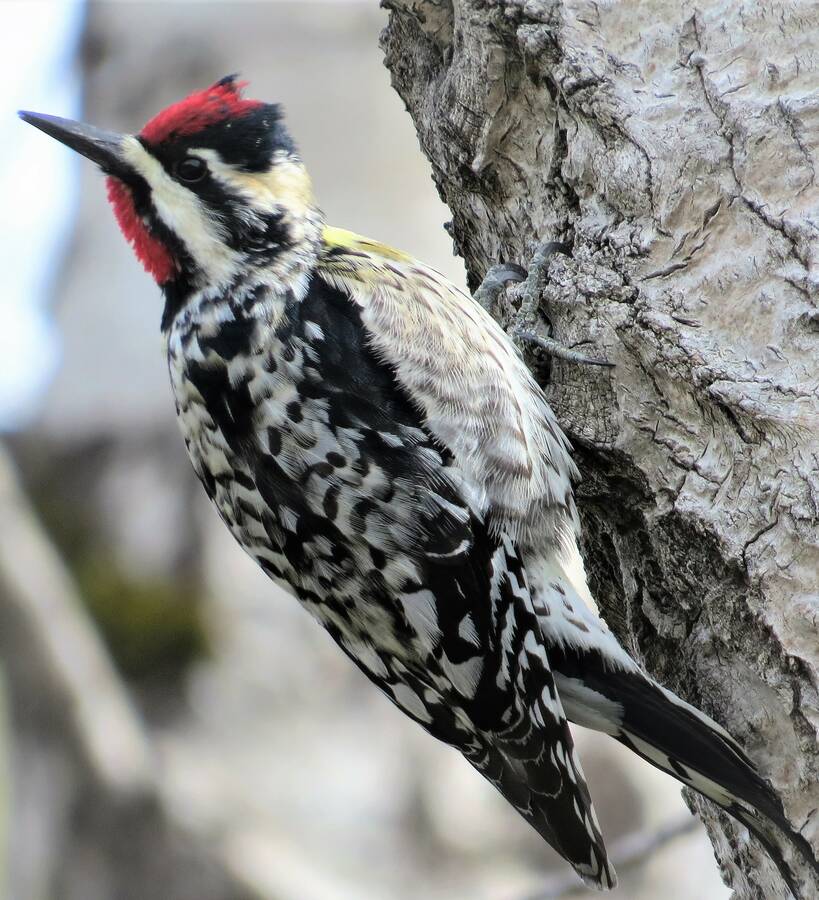
2022-05-18
The yellow-bellied sapsucker
by JAMES HIRTLEAs I drove through Middlewood on May 8 I saw a yellow-bellied sapsucker on a telephone pole alongside the road. I stopped to try and get some photos.
I did not expect to see much more, but I was pleasantly surprised when I sighted a blue-headed vireo and a northern parula both a first for the year. In addition, there was a yellow-rumped warbler, three purple finches, a hermit thrush, a downy woodpecker, a common grackle and a red-breasted nuthatch.
But I'm always thrilled when I find a sapsucker as I really do not get to see this colourful woodpecker very often.
The yellow-bellied sapsucker does breed here in Nova Scotia. They are 20 to 22.5 cm long with a wingspread of 35 to 40 cm. There is a lot of variance in plumage between individuals.
In general, the adults have a scarlet red forehead and a long white stripe down each wing. The back is cross barred with black and white. The male has a patch of red on both the forehead and the throat. The female has a white throat.
Both sexes have two white horizontal stripes across the face one originating at the eyes, the other at the bill. Both have a black bib across the upper breast with straw-yellow underparts. There is a black tail with white bars across the central tail feathers. The immatures are brown and have a long patch of white along the closed wing.
The yellow-bellied sapsucker drills both horizontal and vertical, square or round holes about .625 cm in diameter. They use at least 275 species of coniferous and deciduous trees, also some shrubs and vines, the goal of which is to get at the soft inner bark and to lap up with long, brush-tipped tongues the sap that fills the shallow holes.
These holes also attract insects, hummingbirds, other woodpeckers, warblers, flying squirrels and a number of other animals. In the summer during breeding, the young are fed a mixture of sap and insects. They also eat wasps, ants, hornets, mayflies, stoneflies, moths of forest tent caterpillars, and spruce budworm, as well as beetles, scale insects psyllids and other bark and tree insects.
They also consume fruit and small berries, and buds of aspen. In the winter they will come to backyards for suet, suet mixtures, doughnuts, grape jelly and sugar water in hummingbird feeders.
Other new species for the year for me on May 8 were a swamp sparrow and Wilson's snipe at Hebbville and I heard the rock tapping sound of a Virginia rail on the territory.
Hummingbird reports are coming in from everywhere. On May 3, Marg Millard of White Point had one. On May 4, Janet Corkum of Lunenburg reported her first one for the year. On May 6 a report of one came from Marilyn Sarty. On May 7, Heather Stewart of LaHave saw one. May 8 produced one for Brenda and Greggory Hiltz of Gold River and one for Charles Berry of Bridgewater. There was one in New Germany on May 10, which was seen by Delia Langille. She also sighted some red-winged blackbirds on that day at her place. These birds visit there daily.
A turkey vulture was seen at East Port Medway by Trevor Sarty on April 19. Terry Durnavich of Green Bay saw a pileated woodpecker on May 9. She also reports a resident spruce grouse commonly referred to as a fool's hen. At Back Centre, Steven Hiltz has had a chipping sparrow visiting and at the same time, Charlene MacDonald has been seeing one in First South.
I saw a gray catbird fly across the road in front of my car in Conquerall Bank on May 7. Marg Millard of White Point reported that there was one in her ash tree on May 4. John Solman of Lower Rose Bay let me know about a fairly tame ruffed grouse that follows people around and comes within a few feet of them as recent as May 6. Luke Coldwell found a pine warbler at Lower LaHave.
Lots of good migrants are being seen across the province. Ervin Olsen sighted a magnolia warbler in Quinan on May 6. On the same day, Mark Dennis put the word out about an eastern meadowlark and an eastern wood pewee at Baccaro. Mark also posted a purple martin at Cape Sable Island. This species is likely extirpated in Nova Scotia.
On May 7 Tony Millard reported two great egrets and a snowy egret at Overton. On that day he saw the black-headed grosbeak in Barrington and an eastern kingbird. On May 8 Jason Dain saw a pine warbler at Kejimkujik National Park.
You may reach me at (902) 693-2174 or email jrhbirder@hotmail.com.






